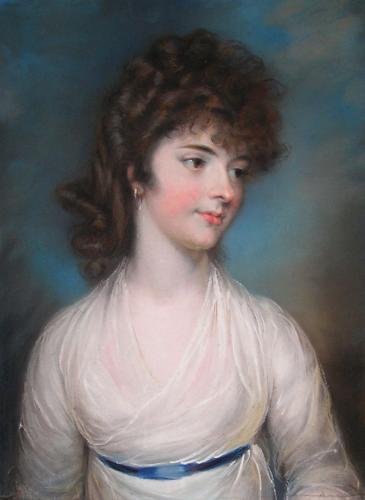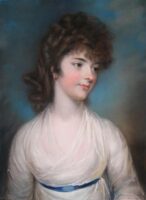Susannah Dearsley Chambers (b.1776)
Guide Price:
SOLDPastel on paper; 24 by 18 in; 61 x 46 cm; held in a gilt wood frame
Provenance: Family descent to Joseph Earle Ollivant (1839-1918); purchased by Conway Wertheimar (1881-1953) and his wife Joan Cicely Young (1898-1995); by descent
Exhibited: Royal Academy 1795, no. 151; Grosvenor Gallery, London 1889
Literature: G. C. Williamson, ‘Catalogue of Pictures of John Russell R. A.’, 1894, p.156; N. Jeffares ‘Dictionary of Pastellists before 1800’ p.449, Unicorn Press, 2006
Susannah Dearsley Chambers was the daughter of Jarvis Chambers (1745-1806) and Sarah Dearsley, of Grove Place, Hackney. Her father, a partner in a city based haberdashers, appears to have been a fairly successful businessman and commissioned the artist John Russell to depict his daughter several times – full length in oils, head and shoulders in both a miniature and in pastel, this being the portrait presented here. These images not only show the talent and diversity of Russell as a painter but demonstrate a strong love of a father for his daughter.
Exhibited at the Royal Academy in 1795 this portrait is typical of Russell’s clientele, the bulk of his work being for the wealthy middle classes rather than the landed aristocracy. His trademark use of blue is clearly apparent as is the subtle softness of form achieved by smudging outlines and highlighting elements such as the folds of the dress and the curls of the hair. He managed to capture such character and expression that though he was sincerely indebted to Francis Cotes his work goes well beyond that of his master.
Probably England’s greatest pastellist, and certainly her most prolific, John Russell was apprenticed to the portraitist Francis Cotes and set up his own practice in 1767. In 1770 he entered the Royal Academy Schools in London, winning the silver medal for figure drawing. Exhibiting at the Society of Artists in 1768 and regularly at the Royal Academy from 1769 to 1806, he was elected ARA in 1772 and RA in 1788, when he became Crayon Painter to King George III and to George, Prince of Wales. He painted occasionally in oil but the main body of his work, hundreds of portraits and a large number of “fancy pictures” depicting children with animals, is in pastel. Given his royal patronage he attracted a large and fashionable following.
With thanks to Neil Jeffares for his help in the cataloguing of this work.


